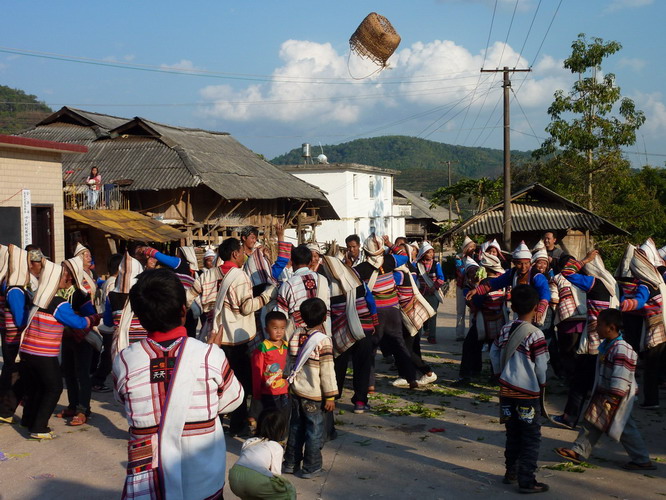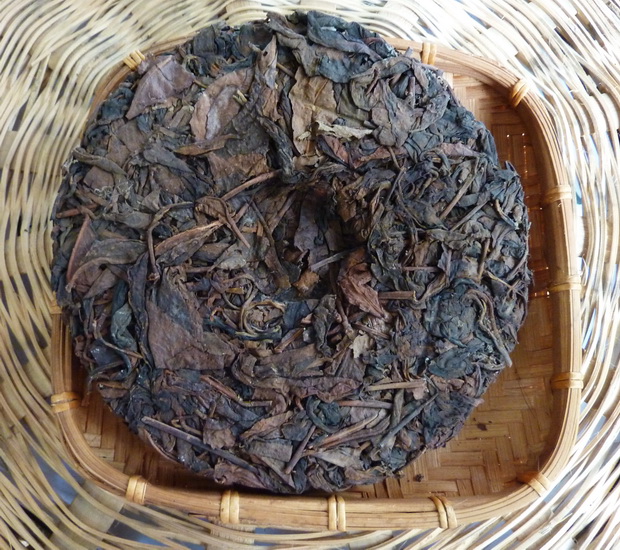Author Archives: Puerman
Afternoon Tea
New Year
Xishuangbanna does not have a particularly strong Han Chinese culture, nonetheless, during this season, many different ethnic groups celebrate their own new year ; Aini, Jinuo, Han, all have celebrations.
This last week has been the Jinuo New Year – several days of celebrations, for which cows and pigs are slaughtered and shared out amongst the households of the village. Much is also given away to guests.
Yesterday I went with friends to Jinuo Shan. We were invited to a friends house to eat. This was followed by dancing.
A group of dancers, accompanied by others playing cymbals and makeshift drums, go round the entire village, enter each house to dance and drink bai jiu and finish in the village square to continue the celebrations.
A basket of greens was tossed in the air above everyone’s heads, while the drinking and dancing continued.
In these situations, avoiding being more or less forced to drink home-made maize liquor takes great determination and – as far as the hosts are concerned – a degree of insensitivity to their cultural norms. However, Jinuo people tend not to be as persistent as some other cultures in this matter.
All Jinuo people will wear some form of traditional dress for this kind of occasion; typically a jacket and a bag. Only the woman wear hats. The clothing is made using cotton that people have woven themselves, though the Jinuo likely never grew much cotton themselves, and although they apparently traditionally dyed cloth themselves using local plant dyes, it seems that this too is seldom practiced now.
There is very little tea in this particular part of Jinuo Shan now. Old tea trees have been cut down to plant rubber which encroaches relentlessly on more traditional farming areas.
making tea

Collecting Yixing pots is an interest that many tea drinkers develop, but for drinking Puer that you’re not familiar with and/or you’re not sure of it’s antecedents , a gaiwan is the best choice. It will produce the most reliable brew with no influence from the receptacle itself. If you’re sampling tea, a gaiwan is a must.
Also, if you can’t stretch to buying a couple of pots – at least for old teas/ young teas, gaiwans provide a more affordable, functional choice.
Furthermore, you don’t want to contaminate your cherished Yixing teapot with some questionable bush tea replete with chemical residues.
Climate Change
I just got back from a month in the UK. The first visit in five years. Of course, I took tea with me. It was the first time I had personally taken much sheng cha from one climate to another, significantly different, climate.
From Jinghong to Kunming, with about 1200 metres rise in altitude, is already a huge change and it requires time, particularly, it seems, for younger teas to adjust. I had taken some Puer to Beijing a couple of years ago, but it was October, when the rainy season in Xishuangbanna is largely over and the weather in Beijing is still pleasantly warm, albeit quite dry, so the change was not so obvious.
Younger teas took the best part of three weeks before they started to taste anything like they do here. And even ‘here’ the change in sheng between dry and wet seasons is very noticeable – most typically losing it’s fragrance whilst the flavour becomes thinner.
I spent a fair amount of time also exploring different waters – bottled, commercially available water – and even went as far as buying a small kettle since, even if you have good water, which you then boil in a calcerous old kettle the result will be compromised.
After trying many waters with different pH and mineral content I concluded – farbeit for me to advertise – that Volvic was the most suitable for the majority of teas. It’s mineral content is not very high – it has very low calcium levels and the pH neutral at 7. The water we use in the shop has a similar profile, but with a few less minerals. It seemed that older teas were a little more tolerant of the cliamte change and poorer water quality.
The correlation of water and altitude (boiling point?) is also interesting; Nan Nuo Shan is blessed with ample crisp spring water. It’s excellent for drinking when walking in the mountains and, at 1600 metres or more, makes a fine brew of tea. But when we have tried bringing that water back to Jinghong to make the same tea, the outcome is rather less favourable. Typically less fragrant and more astringent.
My conclusions in the UK were supported by friends in France whom I went to visit at their home in the Cote de Luberon. They have some good experience of Puer and are very familiar with our teas being frequent visitors to Xishuangbanna. They can be visited in their shop in Lauris ‘Galerie Yunnan’ where I’m sure they would be happy to share tea and stories.
By way of conclusion; of paramount importance is some tenacity in tea-making. If one is trying a new tea, or even a tea that one is familiar with, but in a new situation, experimentation is key. Without the determination to explore
Lao Huang Pian
Recently some 80’s lao huang pian of unknown origin came into our possession, so we brewed it up (‘Aini’ style) in the tea kettle which we also recently had lent to us.
Lao huang pian doesn’t typically provide a big, full flavour, but at this age it makes for a very pleasant experience; smooth, velvety, rounded. The whole mouth is sweet; tongue, upper palate, throat with a light and enjoyable chenwei that, since this tea has been dry stored, has no hint of mouldiness. The cha qi is gentle but strong.
The tea.
The Tetsubin.
The broth.
Spring Teas
It’s been a tricky spring for tea and in a month that’s seen Yiwu farmers fighting (literally) over access/rights to pick tea from a cluster of trees that are on common land and one in which prices of tea went back up to their 1997 levels – particularly Lao Ban Zhang – with the ensuing frenzy as farmers bring in tea from other areas to sell on as their own, we’ve come out of it with some good tea.
We’ve made our first cakes of this years ‘Bulang Zhi Dian’ and will be getting more tea pressed after the weekend. It will be available online soon.
There are plenty of people who will tell you that new sheng is undrinkable: course, rough, bitter, astringent… Allowing a bit of latteral (‘Horses for courses’) , those of such persuasion have likely not had the opportunity to taste a good young tea because, whilst it can be all those things, it doesn’t have to be. Taking some care over which tea one selects; where it comes from, what kind of trees, how it’s picked, how it’s made, how it’s steamed, it is certainly possible to produce tea which is pleasant to drink now.
Waiting several years will bring about changes that will enhance the natural qualities of the tea if stored well, but to wait that long in the hope that the undrinkable tea you bought will become a good tipple is a ‘rags to riches’ scheme that is far from certain.
Rain
Last year was a very dry spring but for tea it was good. This year has been even dryer and it has not been good. By this time last year we had already got a fair amount of tea. This year we, like others we know, have been coming back from Bulang Shan, Nan Nuo Shan, Youle with a kilo or two of tea, but nothing more.
Yesterday, after many dry months it finally rained: Yiwu, Nan Nuo Sahn, Bulang Shan all received a smattering. Hopefully enough for tea trees to start sprouting leaves….
Junk Food
We’d been in the shop drinking tea with someone who has been selling our tea in Shanghai and decided to go to a local cafe for a change of scene. Our customers’ husband asked HM why we didn’t sell Shou Cha.
HM: “There’s more than enough Chinese made junk food in the world, I don’t want to add one drop more!” adding a qualifier, “You continue to study and you’ll begin to understand what I mean.”









